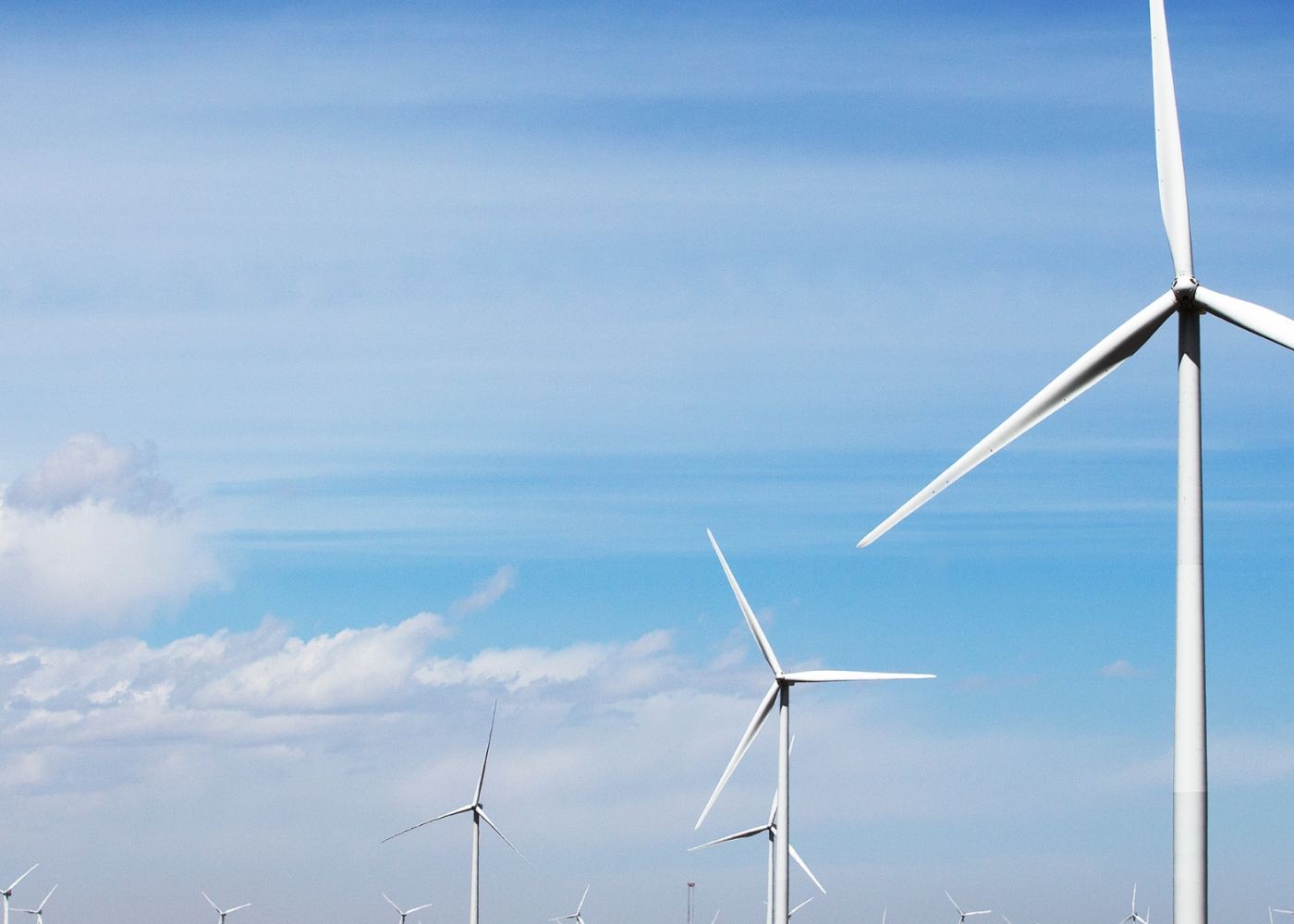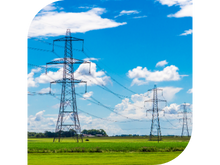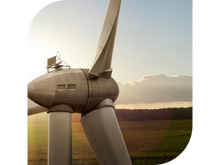Useful facts for talking about onshore wind in Nova Scotia
This page provides useful facts that will answer your questions about the use of onshore wind as a renewable energy source for Nova Scotia and to help you to talk about the subject with confidence.
Come here when you want to:
- understand the energy transition happening now,
- read verified and credible facts about onshore wind, and
- feel confident when talking with your friends and neighbours about Nova Scotia's plans for onshore wind.

BEFORE YOU BEGIN
Tell us how confident you feel now about your knowledge of onshore wind, before reading the facts below.
Remember. Trusted sources are crucial to avoiding misinformation. You play a key role in verifying the credibility of information sources. Be sure that you share accurate and reliable information.
CONTENTS
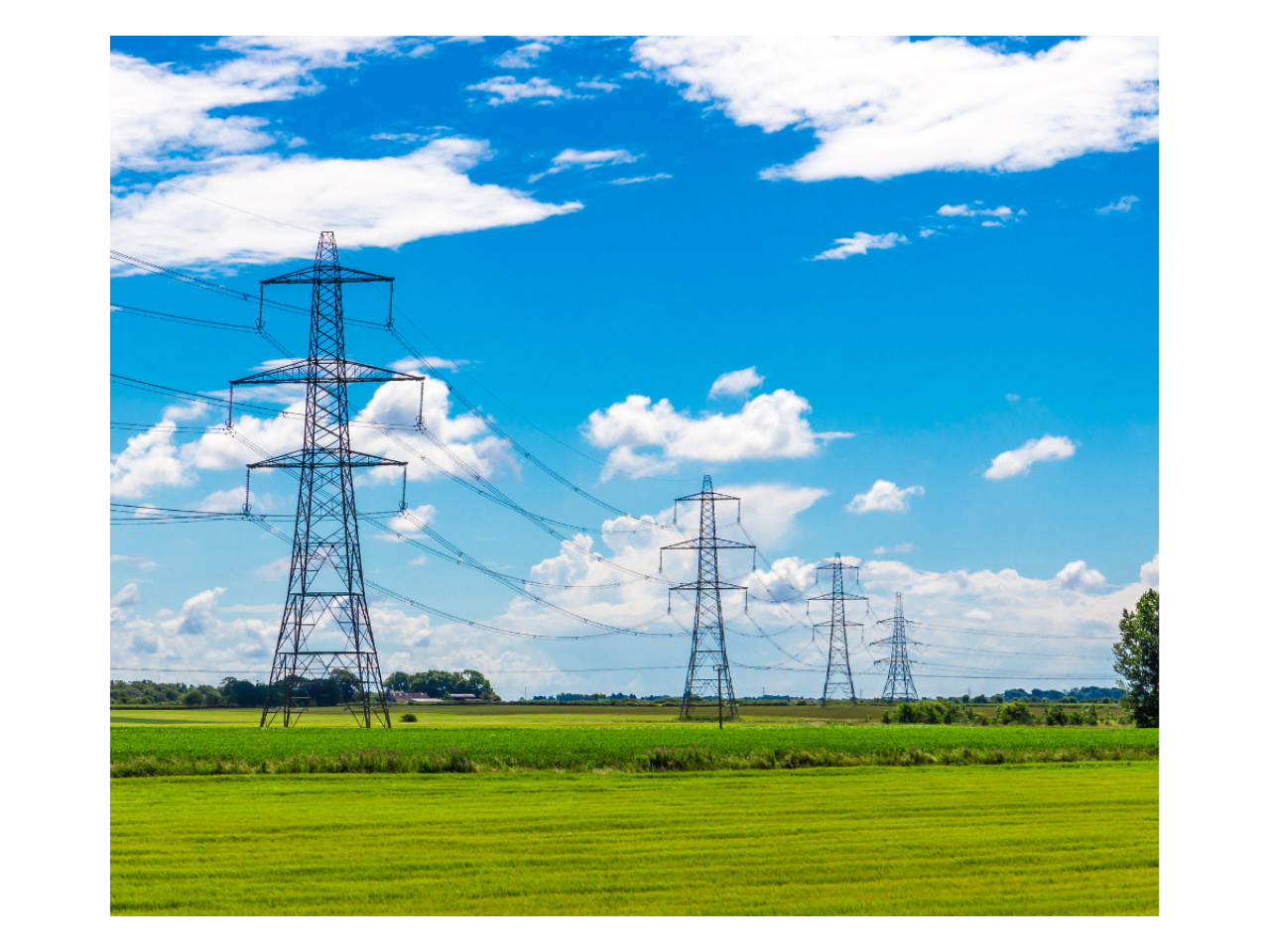
Chapter 1
Ending Nova Scotia's Dependence on Coal
By burning coal for electricity production, we are using the largest contributor to global greenhouse gas emissions, with 43.7% of the world's emissions in 2022, to meet our electricity needs [3] [60]. But we don’t have to.
In this chapter, we look at the reasons why we are moving away from coal and toward renewable energy.
The estimated reading time is 5 min.
Removing coal from the electricity grid is Nova Scotia's way to help fight climate change at home.
Nations have signed international treaties to answer the climate crisis together, and we are increasingly applying innovations and combining resources.
Together, we are moving away from fossil fuels and toward renewable energy sources like wind.
Renewable energy potential in Atlantic Canada is powerful and largely untapped.
Atlantic Canada has many natural resources that can be used to produce renewable electricity. As such, Nova Scotia and the other provinces have set targets and are in various stages of planning and development, including identifying which renewables will meet the provinces' needs and which ones could lead to economic gains as well as environmental benefits.
Communities, academia, government, utilities, private sector companies, and organizations like Net Zero Atlantic are at work to aid in decision-making.
Decisions are being made regarding investments and developments and studies are being conducted to explore the socioeconomic (jobs, healthcare, housing, etc.) impacts and the practical applications (electric grids, manufacturing processes, R&D, etc.) of renewable energy.
Nearly 50% of Nova Scotia’s electricity is generated by coal [9]
The reliance on coal has many well-known negative effects on the environment [1]. It's high level of greenhouse gas emissions affects weather and other global climate systems [3].
Coal has also proven to have more than an environmental cost.
As a major contributor to poor air quality, burning coal has a cost of contributing to asthma, respiratory diseases, and premature deaths [4]. And these human costs add up. Also, burning coal may have an effect leading to higher costs to the health care system and employers due to lost worker productivity [4].
Additionally, the move away from importing fossil fuels toward having a local energy supply is a notable economic benefit for this region.
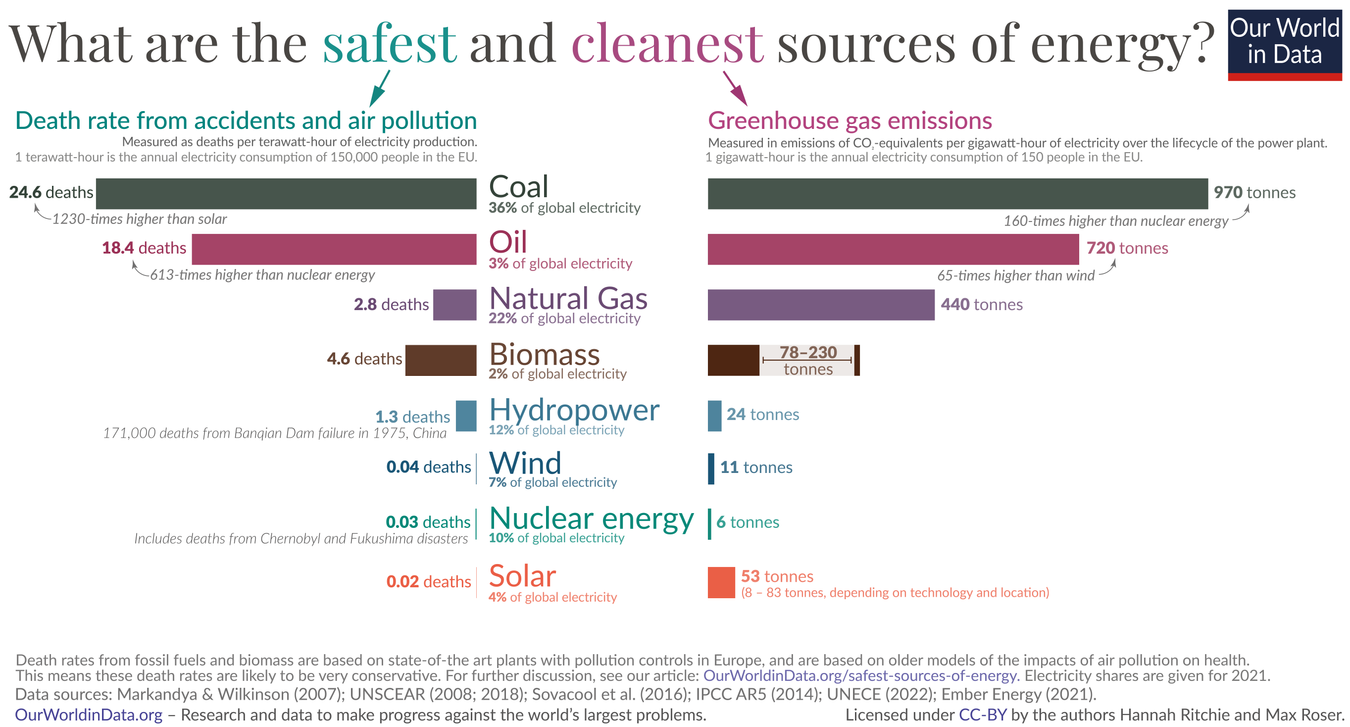
Around 43% electricity comes from renewable energy sources now [68]
To replace coal, Nova Scotia will need several sources of power to form the renewable energy mix. More than one source will help to secure the electricity grid, and wind will be the next big boost.
Nova Scotia has the 2030 Clean Power Plan
Nova Scotia’s plan to reduce greenhouse gas emissions, called the energy transition, are found in the 2030 Clean Power Plan [2]. Nova Scotia's 2030 Clean Power Plan lists what renewable energy sources have potential in Nova Scotia, where progress has been achieved in their development, and what are the next steps. New wind is the next focus area with aims to increase onshore wind's contribution from 20% to 50% of annual electricity generation [2].
Next: Chapter 2 looks into the details of onshore wind.
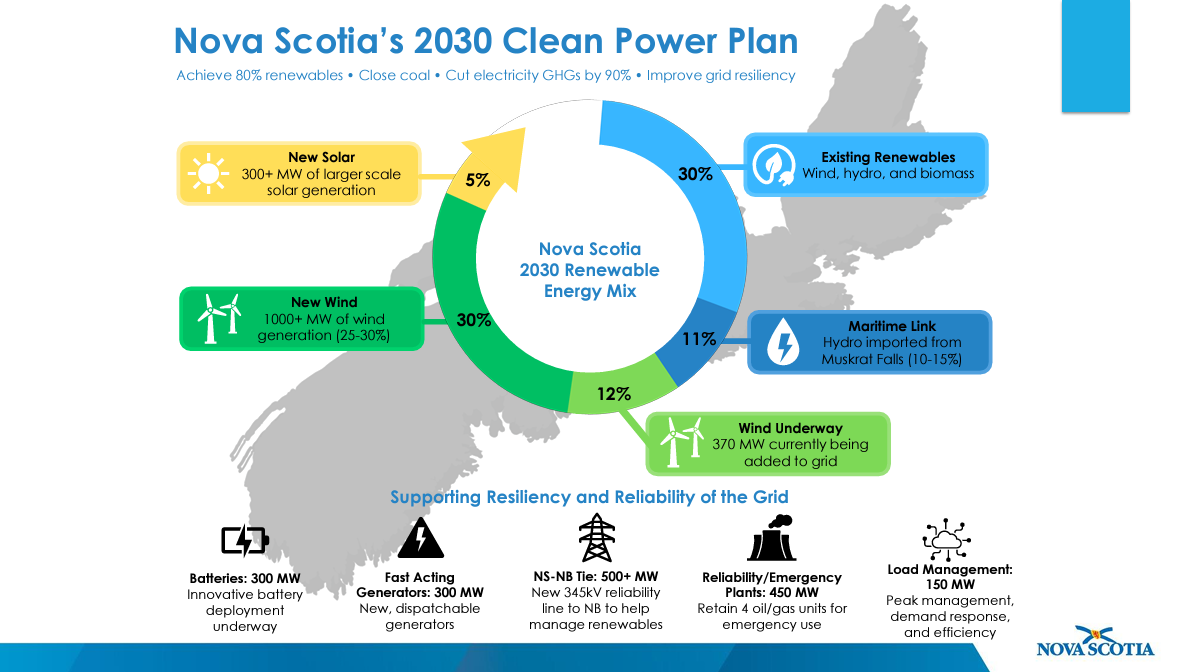
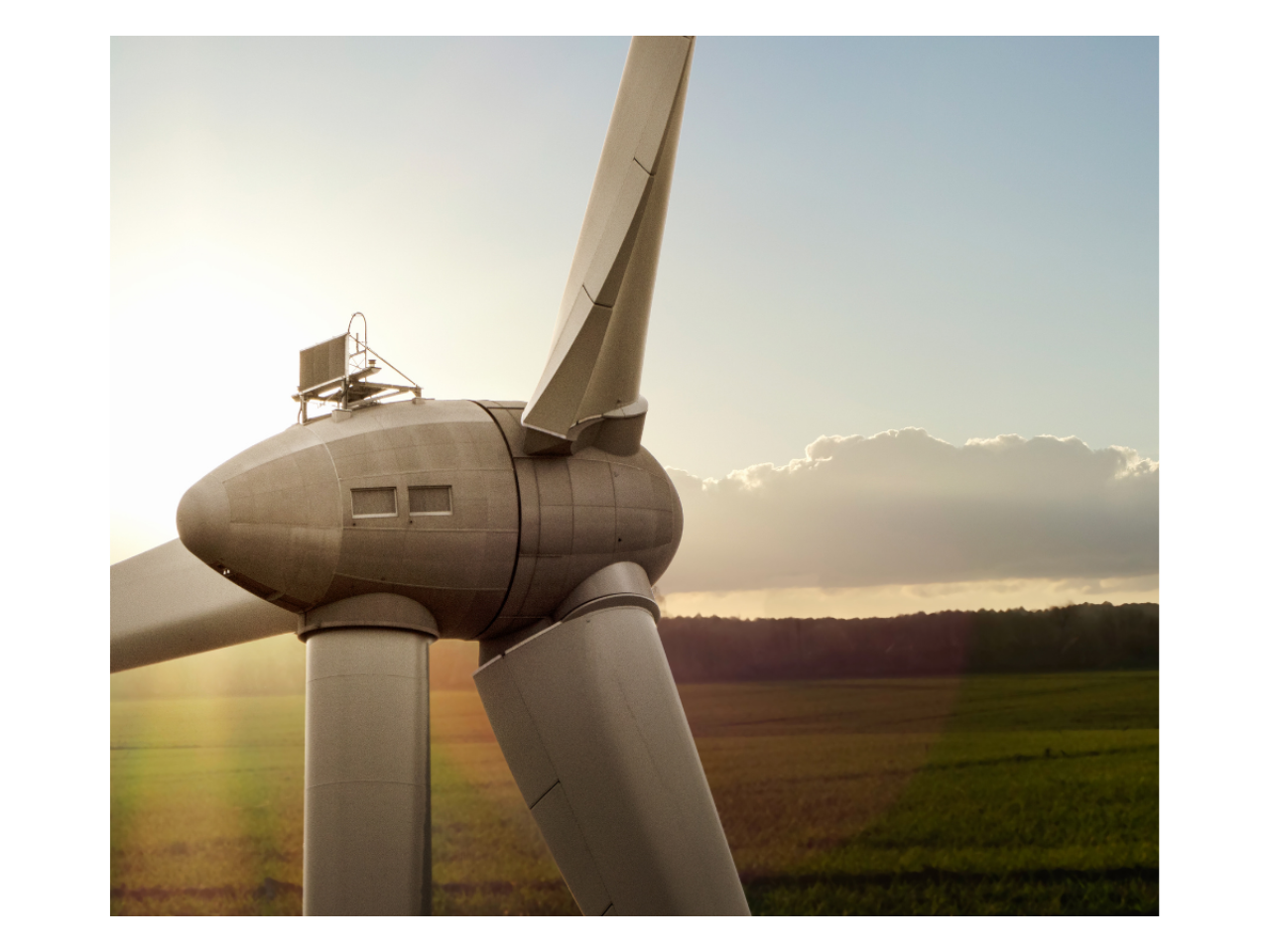
Chapter 2
Why Onshore Wind Energy
While wind power has been used in other parts of the world for centuries [16] [17] [61], the focus on wind as one of the areas for growth in Nova Scotia's renewable energy mix is relatively recent.
In Chapter 2, we look at what makes onshore wind attractive as a renewable energy source.
The estimated reading time is 7 min.
Nova Scotia’s next and best source of renewable energy is wind.
The province's coastal location makes it ideal for wind energy. As Nova Scotia’s 2030 Clean Power Plan shows, the next and best source of electricity is wind. Onshore wind (turbines on land) is where the province began, and offshore wind (turbines mounted on or anchored to a seabed) is a new opportunity to take advantage of our natural wind resource.
Onshore wind speeds are high, even by global standards
Onshore wind is attractive to Nova Scotia because the province has some of the strongest and most consistent wind resources [18] [19]. This region's global and regional wind patterns are known to be world-class, with potential for generating a high amount of electricity every year (known as the annual capacity factor) [62].
Modern wind turbine technology is highly efficient
Advances in materials, aerodynamics, and electronics have made modern wind energy production highly efficient and cost-effective compared to the technology used in older wind turbines [18]. Modern turbines have been designed with taller towers and larger rotor diameters to capture more energy across various wind speeds [17]. This innovation ensures that even in poor conditions, wind turbines can still produce significant amounts of clean electricity [19].
A wind farm's layout can adapt to the land
A wind farm is a collection of turbines set up in specific areas. The farms can vary in size and how they are organized, such as the placement of turbines. A few turbines can be grouped together or there can be large installations, extending across wide open spaces [16].
Wind electricity costs less
Wind as a renewable resource stands out because it is clean, local, and has a low cost of energy compared to other production technologies, emitting minimal greenhouse gases throughout its lifecycle [19] [63]. It is measured by the Levelized Cost of Energy (LCOE), which is “the average cost per unit of energy generated across the lifetime of a new power plant” [15].
Wind's consistent ranking among the cheapest electricity production sources globally, coupled with the trend of declining costs [15] [19] and improving efficiency [16] of technology due to innovations, makes onshore wind an ideal candidate for rapid deployment and large-scale electricity production [17].
Estimated cost per kilowatt hour is 6.75 cents for wind vs. 8.4 cents for fossil fuel
The estimated cost of electricity produced by wind projects in Nova Scotia is estimated to be 5.3 cents per kilowatt hour, based on the latest wind project proposal approved in Nova Scotia in 2022 [2]. In Ontario the projected cost is 6.75 cents, based on a cost comparison published in 2024 [55].
Ultimately, market structures and contracts to purchase electricity generated will determine the impact of wind energy on electricity bills [53]. The estimated cost of electricity produced by fossil fuel is 8.4 per kilowatt hour, according to Nova Scotia Power’s breakdown of service cost by functional areas in 2024 [56].
Onshore wind has local and global market potential
A renewable energy mix for local use, and potentially for export markets, offers notable economic benefits for Nova Scotia. As the energy transition progresses, there will be new opportunities for different groups, such as:
- New job opportunities for residents within the clean energy sector [9].
- Supply chain contributions for communities across the province [2].
- Investment and new business for direct and indirect industries [7] [8] [9].
- Increased revenues for municipalities through land, buildings, and facility taxes [54].
Conditions are in place for growth
To create a favourable environment for wind projects, all levels of government have established supportive policies to encourage renewable energy development [8]. Also, Nova Scotia aims to refine its Action Plan and Roadmap items through an evergreen Integrated Resource Plan (IRP) aimed at evaluating and refining strategies and engage with stakeholders during resource planning [67].
Community engagements are active
Active community engagement potentially creates higher support for renewable energy initiatives enhance the region's feasibility and success of onshore wind developments [19]. Initial responses to onshore wind specifically have been understandably mixed, and consideration of public and private reactions is a part of the transition process.
Next: Chapter 3 explores the responses to onshore wind in Nova Scotia.
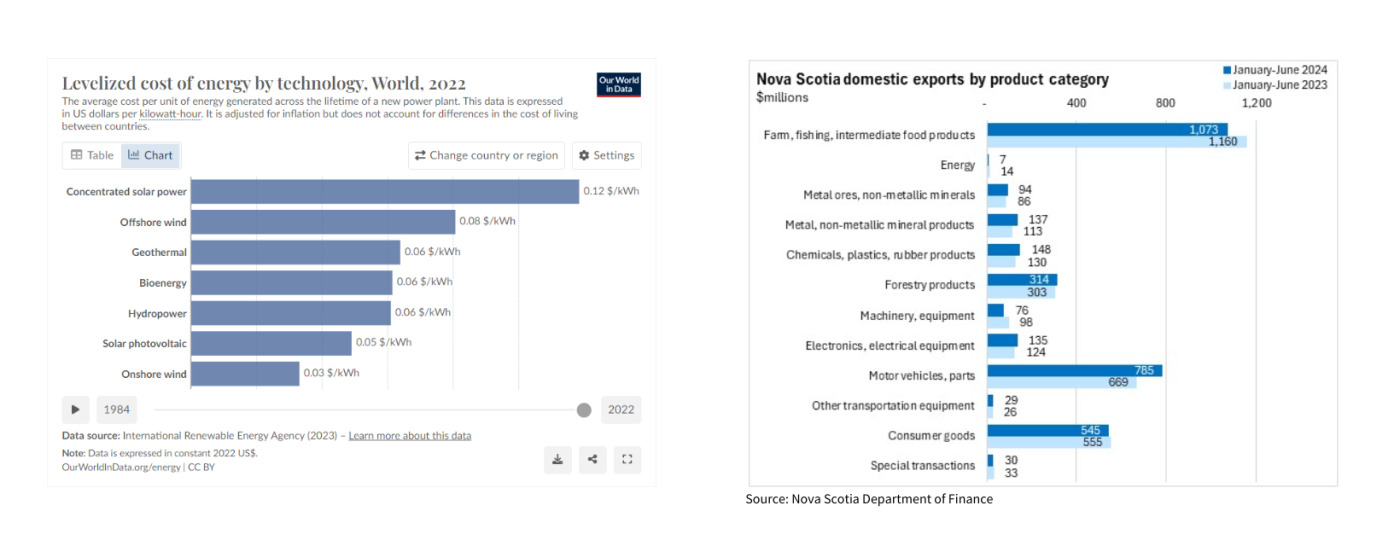

Chapter 3
Responses to Onshore Wind Technology
As with any new and large-scale systems change, there is a mix of known and unknown factors.
In this chapter, we look at what science says will be the human and environmental impacts of wind technology and note what questions remain.
Estimated reading time is 13 min.
Worry over health risks is common
There are many questions about onshore wind and its effects on the environment and humans. Different kinds of research have been conducted to answer questions, including field testing of sound levels and experimental research.
Based on the questions we heard from Nova Scotians here are the relevant findings.
Direct health impacts are unlikely
Moderate and consistent noises from machines inside and nearby homes is commonplace, from the sounds of cars on roads to refrigerators in our kitchens to large-scale manufacturing facilities.
The scientific consensus is that wind turbine noise (WTN) does not cause direct health impacts [20] [21] [22] [23].
Indirect health impacts are possible
Studies have explored the relationship between WTN exposure and changes to self-reported stress response, sleep impact, or other adverse health symptoms [20], often not finding supporting evidence associating both [23] [25].
The impacts you feel can be influenced by your senses. Some people have hearing sensitivities [23] [24], some are annoyed due the look of turbines on the landscape [25], and some find the presence of flickering lights and shadows bothersome. Time of day may also cause annoyance when human activity and machine operations overlap. Discomfort with the unknown can lead to questions over safety, too [20].
Noise level assessments are necessary
Noise levels are calculated by distance plus house barriers
Having a good night's sleep is very important, leading many people to focus on studying the effects of WTN. The Sound Sleep Project determined that when a wind turbine is properly sited, which includes an acceptable setback distance from a home, and the type of turbine and layout is suitable to the area, wind turbines do not pose a risk to sleep for nearby residents [22] [28].
Also, acoustics play a role in the possibility of wind farm noise levels inside the home. The way a home is built can create different kinds of barriers that will affect sound movement.
Studies investigating the physical reactions to infrasound (the sounds humans cannot hear) from wind turbines concluded they are undetectable and not associated with annoyance reactions [20] [29] [30].
Turbines should not be louder than a moderate rainfall [64]
Standards for noise levels have been set globally and a large study was conducted nationally. The World Health Organization (WHO)'s Environmental Noise Guidelines for the European Region is a popular document for setting wind turbine noise regulations [26]. WHO conditionally recommends the outdoor average noise exposure from wind turbines to be below 45dB(A) [26]. Predicted sound levels will vary as distance increases. In Canada, a study found that community noise annoyance drops at distances between 1-2 km from the wind turbine [20].
For a local reference, look at the sound model map below to see distancing applied to a wind farm in Nova Scotia.
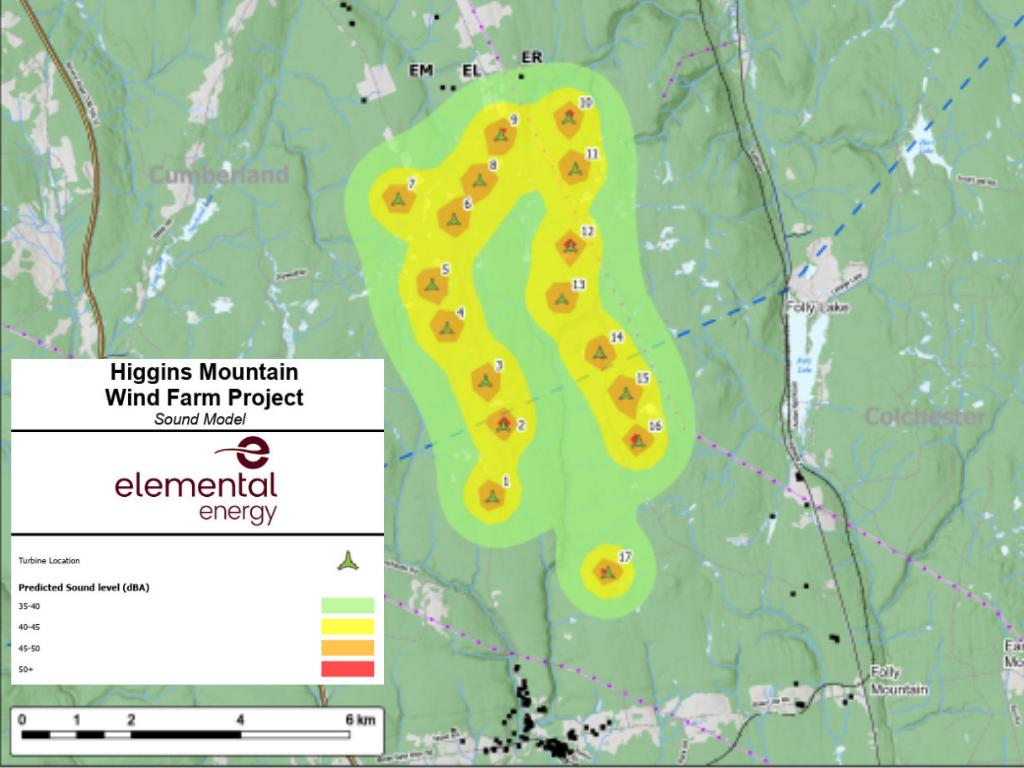
Wind farms mean change
On one side, the move to onshore wind is a large-scale, positive step forward. More electricity generation from renewable resources in Nova Scotia helps to fight climate change, reduce air pollution, and grow a greener economy.
On the other side, the construction and operation of wind farms present the green–green dilemma [65], a recognition that human-related activities lead to known and unknown biodiversity trade-offs.
Efforts to minimize impacts on land, vegetation, and wildlife by wind turbines are crucial [32].
Wind turbine collisions for birds are 1 for every 250 of existing structures
Collisions between birds with human-related activities have been recorded as 1 death by wind turbine for every 250 deaths by collisions with buildings, communication towers, and vehicles as well as cat predation [66]. Lights might attract birds, bats, and insects, but this finding is not widely supported [32].
Annual bird deaths in Atlantic Canada per wind turbine was 0.7 in 2017
A study of all of Canada's wind turbines in 2011, which equaled 3,000 at the time, found that on average 8.2 birds (undefined kinds) die per turbine per year [57]. For 2017, the estimated average mortality rate in Atlantic Canada was 0.7 birds (non-raptors) per turbine per year [58]. Within a global review of studies on environmental impacts found no significant variance of different turbine and rotor dimensions and speed on collision risk [32].
The impacts on wildlife from multiple wind farms could add up over time
Individual wind turbines may not cause population-level effects for most species. However, cumulative impacts across multiple wind farms could affect populations, especially for sensitive species like birds of prey and migratory bats [32]. Displacement might lead to population decline, though there is no consensus on wind turbines' direct impact [35][36][38].
Efforts to minimize impacts are present and growing
Research suggests that:
- For impacts on birds and bats - avoiding wind farm construction high-risk areas [32], employing minimization tactics like acoustic deterrents, visual cues [34], and automatic detection systems [37], and using compensatory measures to create or improve habitats when necessary can minimize risks to birds and bats [32] [35].
- For wildlife impacts- habitat rehabilitation, coordinated planning, and measures to enhance wildlife resource availability can minimize the effects on forests, vegetation, and wildlife [32] [34].
- For visual impacts - implementing fewer turbines with landscape visibility zones, using landscape evaluation models, ensuring clean and appropriately coloured designs, employing vegetation screens, optimizing rotor blades, adjusting light intensity, and avoiding non-mandatory lighting can help reduce visual intrusion (and wildlife attraction) [32].

WHAT ARE YOUR THOUGHTS?
Tell us what excites or worries you about onshore wind energy.
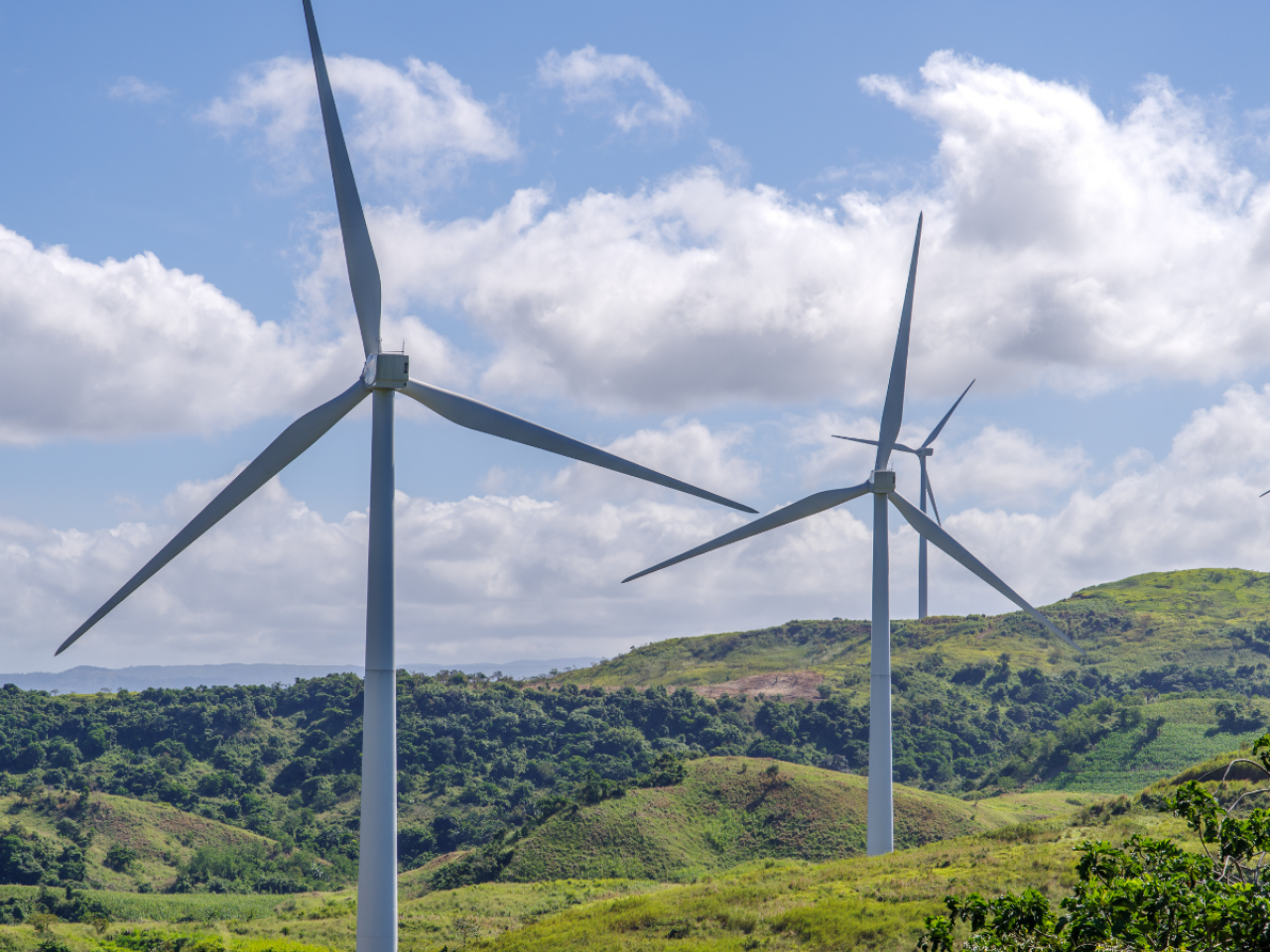
Chapter 4
A Sustainable & Inclusive Energy Transition
The energy transition is happening now. In Chapter 1, we reviewed the need for getting off coal and moving toward renewable energy.
In this fourth and final chapter, we look at how we will get there. And for Net Zero Atlantic, ‘there’ must be sustainable and inclusive.
Estimated reading time is 10 min.
Now is our opportunity to have a sustainable and inclusive energy system
Activities surrounding the energy transition are happening independently and concurrently, and they are being led by many interests, including academia, governments, utilities, private sector companies, Indigenous Peoples, and other non-government organizations.
Net Zero Atlantic is one of the non-profit organizations receiving funds to conduct research, plan engagements, and share reliable information, such as a knowledge hub for wind energy.
Together, we are accelerating action to meet the crisis. Here's how.
Government has many tools to support the transition
Policies and incentives, laws and regulations, and public participation initiatives all express the government's recognition of its responsibility to citizens, residents, and First Nations in the energy transition.
Communities are engaging as a part of the assessment process
Talking about renewable energy leads to many questions. Communities have been engaging in formal and informal forums and providing feedback, especially when a wind project is proposed or in development.
Each registered wind farm project is available to the public for review and to local stakeholders for comment. The record includes the project's effects-management (groundwater, flora and fauna, visual, noise, shadow flicker, etc.) and socio-economic conditions (land use and value, transportation, recreation and tourism, human health, and cultural and heritage resources) [40].
Indigenous knowledge and energy sovereignty are key
When it comes to land and natural resources, Nova Scotia has good reasons to prioritize consultations with the Mi'kmaw, including a legal obligation to consult with Indigenous Peoples in resource development decisions. Indigenous experience and generational knowledge strengthen our ability to make good decisions for the land, water, and air [39].
Setbacks rules are major contributors to long-term sustainability
Where a wind farm can be placed is determined by both municipal and provincial authorities in Nova Scotia. The municipality’s rules are listed in its zoning by-laws. Zoning divides the region, and the by-laws set what distances between wind turbines and homes are acceptable (called setbacks).
Environmental Assessment (EA) process investigates impacts
If a proposed wind project produces at least two megawatts of energy, its impact on the area undergoes an EA. The EA is administered by the Department of Environment and Climate Change and is made available for public review and reviewed by experts in the government. The Minister then decides whether the project can proceed or not and what, if any, conditions should be applied [42].
Mi’kmaq Ecological Knowledge (MEK) Study is an experienced-based best practice
The MEK study provides generational knowledge of land, water, air, and resource development not found in Western knowledge systems. Beyond land, the Mi’kmaq Nation’s rights concern their cultural heritage, traditional knowledge, and traditional cultural expressions. These are part of the EA approval process for a given project.
Siting and setbacks are the next challenges for Nova Scotia
Onshore wind has the potential to significantly contribute to the phase-out of coal. What is being determined now in Nova Scotia are the standards for wind farm locations (sites) and distances (setbacks).
Other countries have faced the same challenge, and we can learn from them.
Getting the location and distance right will minimize impacts
In Chapter 3, the considerations for sustainable development are listed in terms of what is known and unknown. The completion of the Environmental Assessment process and Mi'kmaq Ecological Knowledge Study and the meeting of regulatory standards should help to minimize potential impacts.
Most setbacks in Europe and North America range from 500 to 1,500 metres
Based on Net Zero Atlantic's review of other jurisdictions (countries/provinces/states/territories), setbacks are commonly defined as distances between wind turbines and community infrastructure, such as roads and houses.
Setback standards across Europe and North America range from 500 to 3,200 m, with most of the setbacks ranging from 500 to 1,500 m.
However, in countries such as Poland, Germany, and the U.K., there appears to be a trend in recent years of adjusting standards or regulations to lower setbacks.
For Canada, setback standards generally range from 500 to 1,500 m, a distance consistent with Ontario and New Brunswick.
One size does not fit all, but all agree assigned authority is required
Across Europe and North America, there are three approaches to what government level is given jurisdictional authority to determine wind turbine setbacks.
- State/nation-wide authority, e.g., Maine/U.S. and United Kingdom
- Local authority (i.e., turbine siting subject to local by-laws), e.g., Poland, Delaware/U.S., Ontario, Alberta, New Brunswick, and Scotland.
- Hybrid authority (i.e., both the state and local authority have regulatory authority, often determined by the size of the turbines/wind farm proposed), e.g., Denmark (based on turbine size); Minnesota/U.S. (based on amount of electricity generated); and Germany (based on turbine size).
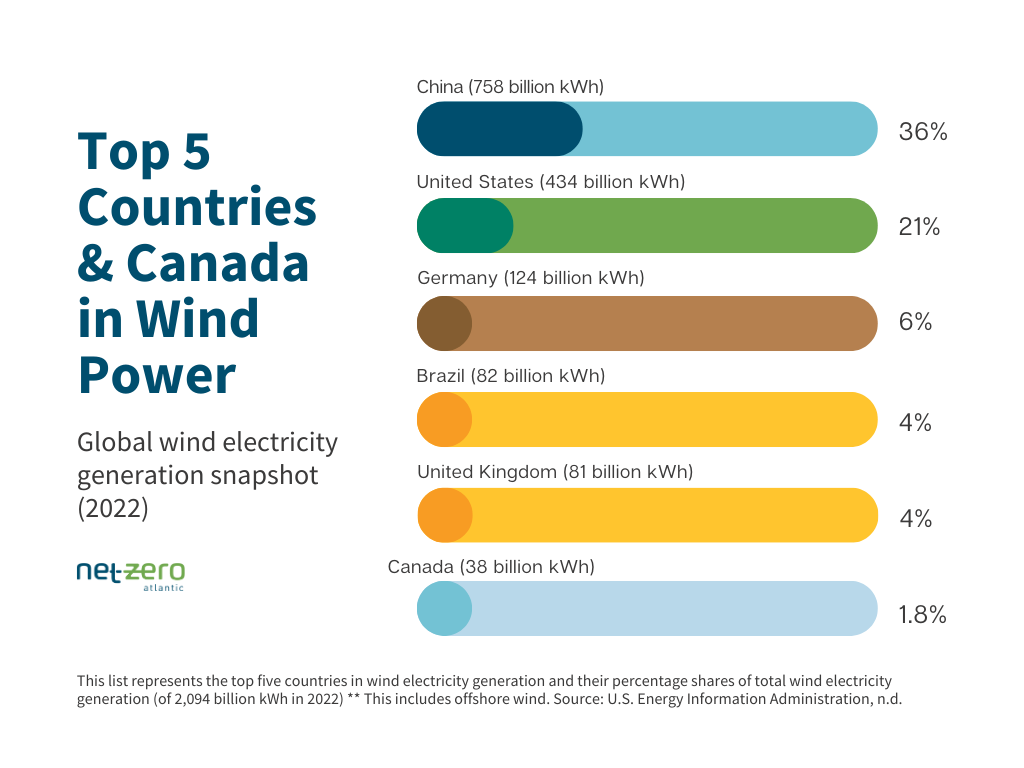
From Chapter 1 to 4, the facts we have provided represent some of what we think you will need to understand to feel confident talking about the energy transition happening now in Nova Scotia, and Atlantic Canada. We have a lot of work ahead of us, but we're getting there.

AFTER SOME FACTS
Tell us how confident you feel now, after reading the facts above.
Don't stop here! We encourage everyone to continue learning by reading the full sources we liked and used to help us organize and state the facts included in this knowledge page. The sources and their links are collected in the Net Zero Onshore Wind Knowledge Page Bibliography.
A big thank you to the Nova Scotia Department of Energy. The department is supporting an education series Net Zero Atlantic is preparing, a part of which is this knowledge page. The staff's openness to our independent work and provision of the data requested in addition to the financial support, are appreciated.

